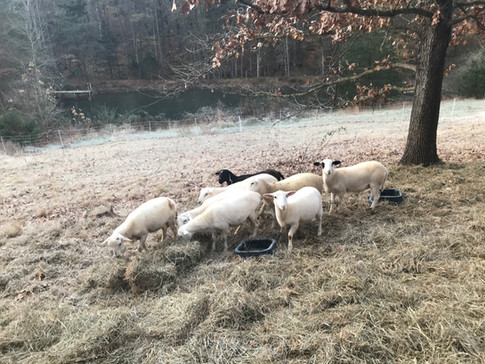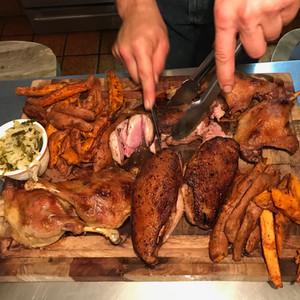Free Union Grass Farm
- Chris and Leah

- Dec 27, 2019
- 11 min read
At this point in the year we have been fortunate to gain experience with lots of different animals and their products. However, we still hadn’t worked with pigs, which was definitely a priority on our list. We had planned a month stay at a pig farm in Maine, but at the last minute they canceled on us. After scrambling to quickly contact farms that are producing pork, we were very lucky to find a diverse and well-managed business in a beautiful setting.

The Farm
Farmer Joel grew up milking ‘Jersey’ cows on his parent’s land. He graduated from college right as the economy collapsed, leaving few good job options. After meeting Erica, a former Polyface Farm Intern, they decided to try turning their interests in livestock and sustainability into a business. Now, Free Union Grass Farm is in its 10th year of raising high-quality meat in Free Union, Virginia.
Their farm raises beef cattle, pigs, ducks (for meat), broilers, and layers. They are also trying out the lamb market for the first time this season. They do all their own slaughter and processing of the poultry on-site. (Warning: this blog contains photos of animals being killed and processed). The farm is located on 13 acres that belong to Joel’s family. The main farm houses the office, freezers, farmstand, kill floor, and some pastureland. They rent about 250 acres of surrounding pasture from neighbors. The rental situation is very advantageous for a small farm. The tax breaks available to landowners for having farming operations on one’s property are so big that many of their neighbors rent them land for little or nothing. One even paid for the installation of underground irrigation, a huge advantage for the farm. While renting does spread out the farm operations, the logistical problems seem well worth the access to pasture.
Although some animals are kept year-round on the farm, the main season runs from March through November. In addition to the two owners, there are 2 full time employees (one seasonal, one year-round). Two additional part-time workers are hired for the labor-intensive poultry processing day(s) each week.
Daily work flow
When working with animals there is always something to check on or something to do. In order to avoid burnout and keep employees happy, Joel and Erica have created an organized and efficient system on the farm. Employee scheduling rotates on a weekly basis, which allows for employees to get two days off in a row. Each week follows a similar pattern that has been refined over time to be logical and efficient.
The day begins as the sun is coming up and (sometimes) the moon is still shining. This makes for some very early days in midsummer, but is essential to meeting the animal’s needs and stopping predators that hunt in the early morning. Chores are the first things to be done every morning. Basically, it's a lot of moving and lifting buckets of food and water. On my first day, Joel's advice to me was, "Never go anywhere without two buckets in your hands." 'The Mule'-basically a beefed-up Honda go-kart is used to efficiently visit the many paddocks to feed and water the animals.

During chores, the mobile shelters are also moved as quickly as possible. The mobile shelters are a unique aspect of this farm. Erica brought her experience from Polyface working with pasture pens or 'chicken tractors' as they are sometimes known. They work for preventing predation, but offer limited space for the animals and require lots of upper-body muscles as the flock size increases. Early in the farm's history they received a mistaken shipment of 200 ducks instead of 50 ducks and didn't have enough pasture pens to house them all. They came up with a plan to put some corrugated metal over an old trailer chassis to provide shade and shelter from aerial predators and surround it with electric net fencing. Erica called this thing a 'Nomad' because it wandered around the field (moved manually by human hands that is). They have since become an important part of increasing farm production and other farms have adopted or adapted the same idea.
After chores, literally every animal on the farm eats breakfast, including the workers! Then we begin moving the animals. Every group of animals is moved 2-4 times per week depending on the weather, maturity of the animals, and other necessary tasks on the farm. Moving animals can take until lunch or sometimes later for the cows. And sometimes they just don't want to get up. Then, it’s time for afternoon chores which include feeding, watering, and collecting eggs.
Tuesdays are processing days. Chickens or ducks are killed, scalded, plucked, eviscerated, chilled, then put in the fridge or freezer.
Wednesdays is “cut-ups” day; where the chilled birds are cut into pieces (breasts, leg/thigh, wings, etc.) and vacuum packed for retail sales. Deliveries to wholesale customers (restaurants and bakeries) also happen on Wednesdays.
Thursdays are a catch-all day for weekly projects.
Friday is preparation for farmer’s markets, as well as hosting the on-site farmstand. Both farmer’s markets they attend are on Saturday. Sunday is intended to be a day of rest, but somebody must still cover morning and afternoon chores. Cleaning and packaging eggs is used to fill gaps in the schedule, as a break from more demanding tasks, or when the weather is really bad for outdoor work.

The farm uses Slack to communicate with each other and to take notes in the field. There are lots of details that need sharing e.g. “The battery for the fence charger needs replacement.” or “Pack market pork from the farmstand freezers, not the bulk freezers.”, and this gives them an easy way to do it. Everyone knows to check the app before doing chores, packing the trucks, etc. This allows changes to be communicated while people are out at the many different paddocks, rather than returning to the center of the farm to check the whiteboard for notes.
The Animals
Chickens – Layers
They raise about 600 layers in two trailers (‘eggmobiles’) surrounded by net fencing until it freezes after which they are moved to a hoophouse for the winter months. The layers are fed once a day in the morning and the eggs are collected in the afternoons. The eggmobile is moved within the paddock twice each week and the whole paddock is moved about once per week. The layers are a Rhode Island Red and Leghorn cross, aka ‘Golden Comet’. This cross is known to produce lots of eggs and gives the customer-preferred brown egg (purebred Leghorns are prolific layers, but lay white eggs). They have sloping nest boxes that pad the egg and move it away from the bird into a covered area to reduce the amount of egg washing necessary. The switch to these expensive nest boxes reduced their egg cleaning from about 50% of eggs to about 25%, quickly paying for itself in reduced labor.
Eggs are sorted (dirty/clean), washed if needed (in hot water with a drop of dish soap), and packaged in special green cartons. While egg profit isn’t large, they feel it’s an important part of attracting people to the stand including; vegetarians, low cost buyers, and a potential gateway for egg customers to buy some meat. When I was there in November, there were no other egg vendors still selling at markets. Our stand sold more than 150 dozen each Saturday in less than 3 hours and could easily have sold more if supply allowed.
Chickens - Broilers
Broilers (meat chickens) are raised in paddocks surrounded by electric net fencing. Each ‘batch’ is about 1200 Freedom Ranger X Cornish Cross, aka ‘Poulet Rouge’ birds. Previously, they raised full Cornish Cross (the typical chicken in every store and every commercial farm), but noticed internal bleeding and muscle damage since they are primarily bred to be fast growing, and not to be running around outside. They switched to full ‘Freedom Rangers’ but thought the breasts were too small and growth a little too slow. So in the end, the Freedom Ranger and Cornish Cross cross was a good compromise of production and animal welfare considerations.

'The bros,' as they call them on the farm, are fed an antibiotic and GMO-free feed morning and afternoon. The intention is to have food (and water) always available to facilitate quick growth. They are received as 1 day old chicks and raised for 4 weeks in the brooder to grow and prepare for life outdoors. Once outside in the electric netting, the paddocks are moved 2 or 3 times each week. The 1200 birds in the paddock are slaughtered in thirds, 400 each at 8, 9, and 10 weeks of age. This keeps the slaughter to one day per week and gives customers a choice of sizes, usually in the 3.5 to 5.5lbs. range.
State law allows them to slaughter up to 20,000 birds on-site with an annual inspection from the Virginia Department of Agriculture. All processing is done on-site. Most birds are sold whole, though they do cut up and sell lots of vacuum sealed portions. Leg/thigh, breast, wings, backs and necks (for stock), livers, hearts, and feet are all packaged separately.

Processing day was always long and intense. In order to be efficient and reduce animal suffering, many time sensitive tasks must be juggled effectively. Participating in this part of the farm was an eye-opening window into the reality involved in meat production. I also witnessed the benefits to the animals, workers, and customers that come from producing sustainable meat on a small scale. For the animals, this includes lots of outdoor space to roam, the opportunity to forage and complete other natural behaviors, the presence of other individuals of the same species, and predator protection. For customers, you can count higher nutrition, better fat, more Omega-3s, and amazing taste. The ecosystem sees more sustainable land use that cycles nutrients, builds soil, and reduces off farm inputs. One of the benefits to me (and the rest of the crew) was a hot lunch cooked by Joel’s mom on busy slaughter days!
Ducks
250 Pekin (‘Grimaud Hybrid’) ducks are kept similarly to the broilers. They receive the same feed, filled 2x/day, and are moved in fenced paddocks. The market for duck meat is very good and they think it is their most profitable animal. There aren’t many duck producers in the local area and they sell about 80% of their ducks wholesale to restaurants. The wholesale price is about 95% of the retail price for whole duck. As a small farm, this margin is amazing as most products have a wholesale price around 50% of retail.
The ducks spend only 2-3 weeks in the brooder and ‘finish’ in 7-8 weeks. Plucking ducks is long and difficult, and the primary bottleneck in the process.
Geese
The farm had about 3 dozen geese spread out between the poultry paddocks. They are used as guard animals to protect the smaller and less aggressive chickens and ducks. Along with their large size, they also make lots of noise when danger is possible, keeping away most predators. Among the possible predators in the area-coyotes, skunks, possums, and birds of prey-the combination of electric net fencing and geese seems to do a good job with nearly all of them, except owls. It is very challenging to defend against an owl’s silent attack in the dark. The occasional headless duck in the morning was evidence of a successful owl attack overnight. At the end of the season, the geese are processed and sold for Thanksgiving and Christmas feasts.


Pigs
The farm raises dozens of mixed breed pigs each year. This was the first year they have tried farrowing their own pigs. While we were there, the pregnant sow gave birth to 8 piglets! Usually, they buy weaner pigs at 8 weeks old and raise them until 6-7 months old. The pigs are kept in forest paddocks surrounded by two single-strand electric wires. They are moved twice each week. They have a giant feeder full of always available feed, as well as whatever they can find in the woods.
Joel considers pigs the lowest amount of labor for the return. Demand for pork is high. In order to sell retail cuts of pork, the pigs must be slaughtered and butchered at an off-farm facility. Pigs are highly intelligent and it takes some strategy and many hands to get them out of the paddock and into the trailer to go to the butcher. But the piglets sure are cute.
Cattle
The farm raises a breed called ‘British White’. White cows can tolerate summer heat better than darker breeds, making these a good selection for the hot and humid Virginia summers. They are also small at birth, reducing the chances for complications during calving. Spring or fall calving is recommended so newborns aren’t subject to the harshest winter conditions.
Currently there are 20 pregnant cows. They are outside all year but get fed hay November through March. The cows are 100% grass-fed and finished. They are usually kept for 30 months, which is quite old for most American beef. The diet and age combine for a delicious and high-value product.
The cattle are sometimes mob grazed on small paddocks, but begin the spring in larger ones to take advantage of quickly growing grass. Then the paddock size shrinks as growth slows through summer and into fall. Each paddock is encompassed by a single electrified wire.
The Markets
Farmer’s Markets make up about 50% of farm sales. They attend two Saturday markets, one 20 miles away in Charlottesville (year-round) and the other 80 miles away in Richmond (April-October). This means for much of the year there are two vans being packed and driving to different locations each weekend. This requires three people, plus another person who must complete the on-farm chores, making Saturday the busiest day of the week.
Set-up and take-down for farmer’s markets as a meat business is easier and faster than I've experienced working for vegetable farms. All the products, with the exception of the eggs, are frozen and kept in large coolers. The coolers are kept behind the stand and individual cuts or pieces are taken out as customers request them. The egg pyramids on the table are the only product immediately visible to customers. This makes signage very important in order to identify the farm among the many vendors at market.

By the time I was there in November they were only attending the Charlottesville market. It’s a large market with a wide diversity of vendors and discerning clientele. I could see the effect the eggs have on drawing people to the stand. Then, once they are at the table, an opportunity to add some beef or bacon to their order opens up. The majority of transactions were by credit card. We hooked up Square to our phones to accept the credit card charges. The farm is serious about record-keeping and every individual product sold is recorded. This gives them information about how many items to bring the following week, as well as how much to produce next year.

The Business
Joel and Erica are incredibly focused and hard-working. I witnessed the attention they give to all aspects of the business. They provided an excellent example of balancing the many aspects of a small farm business-finding a market niche, producing and marketing healthy food, caring for themselves and their workers, and recognizing the importance of animal welfare. It was a great educational experience with great people. The month sure flew by fast and ended with an amazing roasted duck dinner with Joel and the other farmhands.
The Rest
While Chris spent his days on the farm, Leah was hanging with Juniper, reading, working on her portfolio, and taking walks in the pastures by our little apartment we rented. The apartment had amazing radiant heat, so it was a nice cozy space for Leah to take a break from farming. (The real reason we were there though is because Juniper would've chased all the chickens on the farm.) Our place happened to be one exit away from the Blue Ridge Parkway, so we were able to go for lots of longer hikes and scenic drives too. Also a short drive away, or even walk, were dozens of vineyards, breweries, cideries, and distilleries which all added to the picturesque scenery surrounding us. We were able to check out some cool cities in Virginia, like Charlottesville and Richmond, on the weekends too. We lucked out with close to amazing and autumnal weather the entire month. Overall, we really enjoyed our time in Virginia and hope to visit the beautiful state again someday!
We hope everyone had a good holiday season! Stay tune for our last and final 'farm' visit which is actually a meat processing facility in Wisconsin (If you do not wish to see all photos of dead animals then please do not open!)





































































































































































































Comments